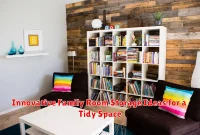Discover how to create a Playroom Perfection: a space that is both fun and educational for children. Learn design tips and ideas for setting up a play area that encourages creativity and learning.
Planning Your Playroom Layout

When it comes to designing a playroom that is both fun and functional, the layout plays a crucial role in creating a space that children will love. Here are some key tips for planning the layout of your playroom:
Consider the Age Group
Start by considering the age group of the children who will be using the playroom. For younger kids, designate a soft play area with plush rugs and floor cushions. For older children, create zones for different activities like reading, arts and crafts, and pretend play.
Maximize Storage
Keeping the playroom organized is essential for a clutter-free space. Incorporate plenty of storage options such as bins, shelves, and baskets to keep toys and supplies neatly stored away. Consider labeling storage containers to help children easily find and put away items.
Create Play Zones
Divide the playroom into different play zones to cater to various interests and activities. You can have a cozy reading nook, an art corner with a table for projects, a dress-up area, and a space for building and construction play. This way, children can easily move between different play areas.
Prioritize Safety
Ensure that the playroom layout prioritizes safety. Opt for furniture with rounded edges, secure heavy items to the wall to prevent tipping, and use soft padding on any sharp corners or edges. Make sure that any electrical outlets are covered and that small items are stored out of reach of younger children.
Include a Comfortable Seating Area
Integrate a comfortable seating area where children can relax and unwind. Bean bags, floor pillows, and child-sized chairs are great options for creating a cozy spot for reading books or playing games. Consider adding a rug to define the seating area and make it inviting.
Allow Room for Growth
Lastly, when planning your playroom layout, remember to allow room for growth and flexibility. Choose furniture and storage solutions that can adapt as children grow and their interests change. Consider incorporating adjustable shelving or modular furniture that can be easily reconfigured.
Educational and Fun Playroom Ideas

Creating a playroom that combines both educational elements and fun activities can be a rewarding project for any family. By designing a space that fosters learning through play, children can develop important skills while having a great time. Here are some ideas to help you achieve playroom perfection:
-
Learning Zones: Divide the playroom into different zones based on educational themes such as reading nooks, art corners, and science exploration areas. This helps children to focus on different types of activities and keeps the space organized.
-
Interactive Wall Displays: Utilize one wall for interactive displays like chalkboard paint, magnetic boards, or a world map. These elements not only provide educational value but also encourage creativity and imagination.
-
Storage Solutions: Incorporate plenty of storage options such as bins, shelves, and labeled containers to keep toys and educational materials organized. This makes it easier for children to access and clean up after playtime.
-
Sensory Play Activities: Include sensory play elements like a sandbox, water table, or sensory bins filled with various textures. These activities engage multiple senses and promote cognitive development in children of all ages.
-
Literacy Corners: Create a cozy reading nook with a bookshelf filled with age-appropriate books, comfy seating, and good lighting. Encouraging a love for reading from an early age is crucial for children’s academic success.
-
STEM Toys and Games: Introduce STEM (science, technology, engineering, and math) toys and games to the playroom to promote critical thinking and problem-solving skills. Building blocks, puzzles, and coding games are great options for hands-on learning.
Storage Solutions for Toys and Games

In creating a perfect playroom designed for both fun and learning, one crucial aspect to consider is efficient storage solutions for toys and games. With the right storage solutions, you can keep the playroom organized, visually appealing, and conducive to sparking creativity and imagination.
1. Open Shelving
Open shelving units are a versatile storage solution for toys and games. They provide easy access to toys, making it simple for kids to see and pick out what they want to play with. To enhance the visual appeal, consider using baskets or bins to categorize different types of toys.
2. Labeled Bins and Baskets
Using labeled bins and baskets is a practical way to keep toys and games organized. Labeling helps children learn about categorization and also makes cleanup time more manageable. Opt for bright and colorful labels to make it exciting for kids to participate in tidying up.
3. Wall Storage Systems
Maximize wall space by incorporating wall storage systems such as pegboards, hooks, or floating shelves. These systems not only save floor space but also provide a creative way to display and store toys and games. Utilize different wall storage options to cater to various types of toys and games.
4. Multi-Functional Furniture
Invest in multi-functional furniture pieces that offer hidden storage compartments. Items like ottomans with built-in storage or coffee tables with drawers can serve dual purposes by providing seating or play surfaces while storing toys out of sight when not in use.
5. Rotating Toy Organizers
Rotating toy organizers, such as tiered storage bins or carousel-style organizers, are excellent for maximizing space efficiency. These organizers allow easy access to a variety of toys without cluttering the playroom. Consider rotating toys periodically to maintain freshness and keep kids engaged.
Conclusion
Creating a playroom that blends fun and learning is key to fostering a child’s development. By incorporating colorful decor, interactive educational toys, and comfortable seating, parents can design a space that encourages creativity, imagination, and growth.




